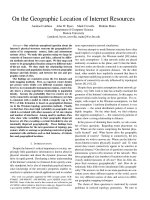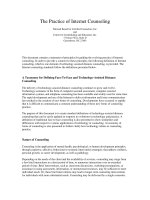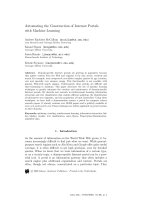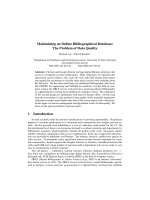The Practice of Internet Counseling potx
Bạn đang xem bản rút gọn của tài liệu. Xem và tải ngay bản đầy đủ của tài liệu tại đây (30.26 KB, 6 trang )
The Practice of Internet Counseling
National Board for Certified Counselors, Inc.
and
Center for Credentialing and Education, Inc.
3 Terrace Way, Suite D
Greensboro, NC 27403
This document contains a statement of principles for guiding the evolving practice of Internet
counseling. In order to provide a context for these principles, the following definition of Internet
counseling, which is one element of technology-assisted distance counseling, is provided. The
Internet counseling standards follow the definitions presented below.
A Taxonomy for Defining Face-To-Face and Technology-Assisted Distance
Counseling
The delivery of technology-assisted distance counseling continues to grow and evolve.
Technology assistance in the form of computer-assisted assessment, computer-assisted
information systems, and telephone counseling has been available and widely used for some time.
The rapid development and use of the Internet to deliver information and foster communication
has resulted in the creation of new forms of counseling. Developments have occurred so rapidly
that it is difficult to communicate a common understanding of these new forms of counseling
practice.
The purpose of this document is to create standard definitions of technology-assisted distance
counseling that can be easily updated in response to evolutions in technology and practice. A
definition of traditional face-to-face counseling is also presented to show similarities and
differences with respect to various applications of technology in counseling. A taxonomy of
forms of counseling is also presented to further clarify how technology relates to counseling
practice.
Nature of Counseling
Counseling is the application of mental health, psychological, or human development principles,
through cognitive, affective, behavioral or systemic intervention strategies, that address wellness,
personal growth, or career development, as well as pathology.
Depending on the needs of the client and the availability of services, counseling may range from
a few brief interactions in a short period of time, to numerous interactions over an extended
period of time. Brief interventions, such as classroom discussions, workshop presentations, or
assistance in using assessment, information, or instructional resources, may be sufficient to meet
individual needs. Or, these brief interventions may lead to longer-term counseling interventions
for individuals with more substantial needs. Counseling may be delivered by a single counselor,
two counselors working collaboratively, or a single counselor with brief assistance from another
counselor who has specialized expertise that is needed by the client.
Forms of Counseling
Counseling can be delivered in a variety of forms that share the definition presented above. Forms
of counseling differ with respect to participants, delivery location, communication medium, and
interaction process. Counseling participants can be individuals, couples, or groups. The
location for counseling delivery can be face-to-face or at a distance with the assistance of
technology. The communication medium for counseling can be what is read from text, what is
heard from audio, or what is seen and heard in person or from video. The interaction process for
counseling can be synchronous or asynchronous. Synchronous interaction occurs with little or
no gap in time between the responses of the counselor and the client. Asynchronous interaction
occurs with a gap in time between the responses of the counselor and the client.
The selection of a specific form of counseling is based on the needs and preferences of the client
within the range of services available. Distance counseling supplements face-to-face counseling
by providing increased access to counseling on the basis of necessity or convenience. Barriers,
such as being a long distance from counseling services, geographic separation of a couple, or
limited physical mobility as a result of having a disability, can make it necessary to provide
counseling at a distance. Options, such as scheduling counseling sessions outside of traditional
service delivery hours or delivering counseling services at a place of residence or employment,
can make it more convenient to provide counseling at a distance.
A Taxonomy of Forms of Counseling Practice. Table 1 presents a taxonomy of currently
available forms of counseling practice. This schema is intended to show the relationships among
counseling forms.
Table 1 - A Taxonomy of Face-To-Face and Technology-Assisted Distance Counseling
Counseling
• Face-To-Face Counseling
o Individual Counseling
o Couple Counseling
o Group Counseling
• Technology-Assisted Distance Counseling
Telecounseling
o Telephone-Based Individual Counseling
o Telephone-Based Couple Counseling
o Telephone-Based Group Counseling
Internet Counseling
o E-Mail-Based Individual Counseling
o Chat-Based Individual Counseling
o Chat-Based Couple Counseling
o Chat-Based Group Counseling
o Video-Based Individual Counseling
o Video-Based Couple Counseling
o Video-Based Group Counseling
Definitions
Counseling is the application of mental health, psychological, or human development principles,
through cognitive, affective, behavioral or systemic intervention strategies, that address wellness,
personal growth, or career development, as well as pathology.
Face-to-face counseling for individuals, couples, and groups involves synchronous interaction
between and among counselors and clients using what is seen and heard in person to
communicate.
Technology-assisted distance counseling for individuals, couples, and groups involves the use of
the telephone or the computer to enable counselors and clients to communicate at a distance when
circumstances make this approach necessary or convenient.
Telecounseling involves synchronous distance interaction among counselors and clients using
one-to-one or conferencing features of the telephone to communicate.
Telephone-based individual counseling involves synchronous distance interaction between a
counselor and a client using what is heard via audio to communicate.
Telephone-based couple counseling involves synchronous distance interaction among a counselor
or counselors and a couple using what is heard via audio to communicate.
Telephone-based group counseling involves synchronous distance interaction among counselors
and clients using what is heard via audio to communicate.
Internet counseling involves asynchronous and synchronous distance interaction among
counselors and clients using e-mail, chat, and videoconferencing features of the Internet to
communicate.
E-mail-based individual Internet counseling involves asynchronous distance interaction between
counselor and client using what is read via text to communicate.
Chat-based individual Internet counseling involves synchronous distance interaction between
counselor and client using what is read via text to communicate.
Chat-based couple Internet counseling involves synchronous distance interaction among a
counselor or counselors and a couple using what is read via text to communicate.
Chat-based group Internet counseling involves synchronous distance interaction among
counselors and clients using what is read via text to communicate.
Video-based individual Internet counseling involves synchronous distance interaction between
counselor and client using what is seen and heard via video to communicate.
Video-based couple Internet counseling involves synchronous distance interaction among a
counselor or counselors and a couple using what is seen and heard via video to communicate.
Video-based group Internet counseling involves synchronous distance interaction among
counselors and clients using what is seen and heard via video to communicate.
Standards for the Ethical Practice of Internet Counseling
These standards govern the practice of Internet counseling and are intended for use by counselors,
clients, the public, counselor educators, and organizations that examine and deliver Internet
counseling. These standards are intended to address practices that are unique to Internet
counseling and Internet counselors and do not duplicate principles found in traditional codes of
ethics.
These Internet counseling standards of practice are based upon the principles of ethical practice
embodied in the NBCC Code of Ethics. Therefore, these standards should be used in conjunction
with the most recent version of the NBCC ethical code. Related content in the NBCC Code are
indicated in parentheses after each standard.
Recognizing that significant new technology emerges continuously, these standards should be
reviewed frequently. It is also recognized that Internet counseling ethics cases should be reviewed
in light of delivery systems existing at the moment rather than at the time the standards were
adopted.
In addition to following the NBCC® Code of Ethics pertaining to the practice of professional
counseling, Internet counselors shall observe the following standards of practice:
Internet Counseling Relationship
1. In situations where it is difficult to verify the identity of the Internet client, steps are
taken to address impostor concerns, such as by using code words or numbers.
2. Internet counselors determine if a client is a minor and therefore in need of
parental/guardian consent. When parent/guardian consent is required to provide Internet
counseling to minors, the identity of the consenting person is verified.
3. As part of the counseling orientation process, the Internet counselor explains to clients
the procedures for contacting the Internet counselor when he or she is off-line and, in the
case of asynchronous counseling, how often e-mail messages will be checked by the
Internet counselor.
4. As part of the counseling orientation process, the Internet counselor explains to clients
the possibility of technology failure and discusses alternative modes of communication, if
that failure occurs.
5. As part of the counseling orientation process, the Internet counselor explains to clients
how to cope with potential misunderstandings when visual cues do not exist.
6. As a part of the counseling orientation process, the Internet counselor collaborates with
the Internet client to identify an appropriately trained professional who can provide local
assistance, including crisis intervention, if needed. The Internet counselor and Internet
client should also collaborate to determine the local crisis hotline telephone number and
the local emergency telephone number.
7. The Internet counselor has an obligation, when appropriate, to make clients aware of free
public access points to the Internet within the community for accessing Internet
counseling or Web-based assessment, information, and instructional resources.
8. Within the limits of readily available technology, Internet counselors have an obligation
to make their Web site a barrier-free environment to clients with disabilities.
9. Internet counselors are aware that some clients may communicate in different languages,
live in different time zones, and have unique cultural perspectives. Internet counselors are
also aware that local conditions and events may impact the client.
Confidentiality in Internet Counseling
10. The Internet counselor informs Internet clients of encryption methods being used to help
insure the security of client/counselor/supervisor communications.
Encryption methods should be used whenever possible. If encryption is not made
available to clients, clients must be informed of the potential hazards of unsecured
communication on the Internet. Hazards may include unauthorized monitoring of
transmissions and/or records of Internet counseling sessions.
11. The Internet counselor informs Internet clients if, how, and how long session data are
being preserved.
Session data may include Internet counselor/Internet client e-mail, test results,
audio/video session recordings, session notes, and counselor/supervisor communications.
The likelihood of electronic sessions being preserved is greater because of the ease and
decreased costs involved in recording. Thus, its potential use in supervision, research, and
legal proceedings increases.
12. Internet counselors follow appropriate procedures regarding the release of information for
sharing Internet client information with other electronic sources.
Because of the relative ease with which e-mail messages can be forwarded to formal and
casual referral sources, Internet counselors must work to insure the confidentiality of the
Internet counseling relationship.
Legal Considerations, Licensure, and Certification
13. Internet counselors review pertinent legal and ethical codes for guidance on the practice
of Internet counseling and supervision.
Local, state, provincial, and national statutes as well as codes of professional membership
organizations, professional certifying bodies, and state or provincial licensing boards
need to be reviewed. Also, as varying state rules and opinions exist on questions
pertaining to whether Internet counseling takes place in the Internet counselor's location
or the Internet client's location, it is important to review codes in the counselor's home
jurisdiction as well as the client's. Internet counselors also consider carefully local
customs regarding age of consent and child abuse reporting, and liability insurance
policies need to be reviewed to determine if the practice of Internet counseling is a
covered activity.
14. The Internet counselor's Web site provides links to websites of all appropriate
certification bodies and licensure boards to facilitate consumer protection.









